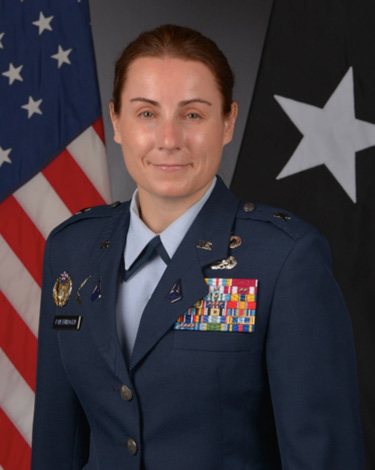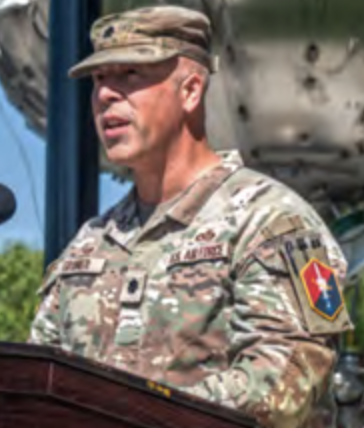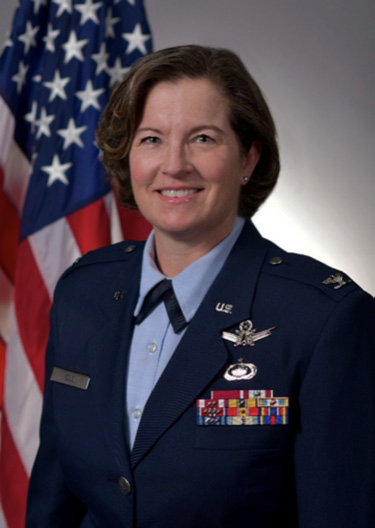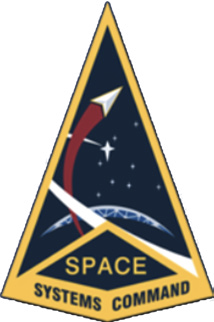Brad Smith, Space Systems Command Public Affairs.
When a spacecraft soars aloft from U.S. spaceports in California or Florida, odds are its success rides on the more than 70 years of experience in launch vehicle development and operations by what is today the United States Space Force’s Space Systems Command (SSC).

“This is rocket science, right?” said Brig. Gen. Kirstin L. Panzenhagen, program executive officer for SSC’s Assured Access to Space, (AATS) responsible for final approval authority for all launches from Florida’s Eastern Range, including from NASA’s Kennedy Space Center. “Developing rockets, designing them, producing them, flying them – this work is hard.”

Brigadier
General Kirstin L.
Panzenhagen
Space Systems Command, headquartered at Los Angeles Air Force Base (LAAFB) and responsible for Vandenberg Space Force Base (SFB) in California and Patrick Space Force Base (SFB) in Florida, is the U.S. Space Force (USSF) field command responsible for acquiring and delivering space capabilities for the U.S. and its allies. This includes managing a $15.6 billion space acquisition budget for the U.S. Department of Defense (DoD).

SSC’s heritage goes back more than seven decades, to the U.S. Air Force’s Western Development Division (WDD), established in 1954 to lead the development of missiles and satellite launch vehicles for the United States Air Force (USAF).
These have ranged from the Cold War-era Atlas and Titan projects to the Evolved Expendable Launch Vehicle (EELV) programs of the 1990s to today’s National Security Space Launch (NSSL) and Rocket Systems Launch Program (RSLP) efforts.
These launch vehicles include a mix of liquid-fueled rocket engines and solid fuel rocket motors, as first stages, boosters, and upper stages, experts said.

John Steinmeyer
“Gen. Sam Greaves, a former SSC commander, often told me ‘Without launch, the critical satellites that SSC fields would effectively be museum pieces … no better than potted plants’ and I couldn’t agree with him more,” said John Steinmeyer, executive director of the Assured Access to Space (AATS) program office at SSC and a veteran of space launch for more than 35 years. “We execute launches for the Space Force but also other DoD agencies. All these organizations’ collective success is really dependent upon our success, and we are fortunate to have a great record in that regard.”
Many roles
in support
With a workforce of more than 20,000, SSC delivers capabilities through six program executive offices, including AATS, that supports national space needs that range from satellite payloads to launching those satellites that are used for space-based early warning, intelligence, reconnaissance, navigation (ISR), and communications, and for both military and civilian users, officials said.

Lt. Col. Sean
Granier,
commander of
the 61st Civil
Engineering
Logistics
Squadron
“As the primary acquisition hub of the Space Force, SSC is charged with understanding the ever-evolving threat, delivering capabilities to counter it, and determining how to leverage those capabilities to succeed,” said Lt. Gen. Philip Garrant, commander of Space Systems Command. “Space is woven into almost every aspect of our daily lives.”
In turn, SSC’s AATS team procures launch services and delivers on-orbit capabilities via satellites used by the U.S. military’s various combatant commands, intelligence agencies, civilian services, and the commercial space industry.
“This is our core launch mission … responsive and reliable launch,” said Panzenhagen, who, in addition to her role as AATS PEO, also serves as director of the Eastern Range and director of SSC Launch and Range Operations. “When we think about the geopolitical environment we’re in today, with great power competition, the ability to operate in tactically relevant timelines is critical - not just for being able to put assets on orbit that our warfighters and our intelligence community need, but for the deterrent aspect of having that capability.”
SSC’s workforce of military, civilian, and contractor personnel also manages range sustainment programs in support of the DoD and commercial launch customers. These facilities include Vandenberg SFB, Patrick SFB, Cape Canaveral Space Force Station, and the associated Eastern and Western ranges, all of which must be maintained to support DoD, civil, and commercial launches.
“It’s not just the mobile service tower, it’s not simply the vehicle-specific integration buildings; it’s everything else in the spaceport,” Panzenhagen said. “Think about roads, bridges, airfields, ports, power, information technology, water - all of those things.”
Those tasks, of course, tie directly to SSC’s larger mission of delivering integrated and resilient space capabilities for the United States and its allies, especially in the face of looming challenges from China and Russia.
“China is no longer a future threat; they’re a threat today,” Garrant said. “They launched their 1,000th satellite into orbit in September, and they’re heavily investing in counter space capabilities, with the intent to present a serious threat to U.S. national security interests in, from, and to space.”
Mission
assurance
Along with SSC’s budgetary and acquisition roles, program management and mission assurance are key elements of what the organization brings to the table, officials said.

Colonel James
Horne
“When it comes to space launch, the work is very, very hard,” said Col. James Horne, a senior AATS officer. “No matter how easy a launch looks, it is a controlled explosion and there are thousands of things, if not more, that have to go right for it to be successful - but only one thing has to go wrong for it to potentially fail.”

An Atlas 2 launch, historic photo
courtesy of Lockheed Martin.
Those capabilities have led to an enviable track record: DoD-led satellite launches, managed by SSC or its predecessor organizations, have not had a launch failure for some 25 years. Three failed National Security Space launches across 1998-99 led to a deep review of launch vehicle and spacecraft design and practices, and strengthened the emphasis on mission assurance, SSC experts said.
“This is the government looking into the design, the processes of the launch vehicle provider (company), to make sure that our ‘no fail’ missions are going to be launched successfully,” said Panzenhagen, who, in her quad-hatted role, is also responsible for organizing, training and equipping government personnel at bases in California, Florida, and New Mexico, among other locations.
The Defense Department defines mission assurance as processes “to protect and maintain critical assets and capabilities supporting the DoD’s military-essential functions. It focuses on resilience, risk reduction, and integration of protective measures to ensure the continued function and readiness of the DoD in the face of various threats and hazards.”

Firefly Aerospace’s Alpha FLTA003, carrying
the VICTUS NOX satellite for the U.S. Space
Force’s Space Systems Command, successfully
lifted off Sept. 14, 2023 from Space Launch
Complex 2 West (SLC-2W) at Vandenberg SFB.
Photo is courtesy of Firefly Aerospace.
As important as that work is, when it comes to what SSC and AATS do, there are different levels of the organizations’ oversight of launch providers, based on the needs of a given launch and the capabilities of a given spacecraft, officials said.
“There are varying levels of mission assurance, meaning varying levels of what we’ll say are government checks into the design, the companies’ processes, companies’ performance,” Panzenhagen said. “There are a lot of government checks on our ‘no fail’ missions.”
Managing multiple
launch vehicle
programs
In 2024, the SSC/AATS team has simultaneously managed acquisition and support of launch vehicle operations under essentially two main programs: National Security Space Launch (NSSL) and the Rocket Systems Launch Program (RSLP).
The NSSL program currently has three launch providers on contract: SpaceX, United Launch Alliance (ULA), and Blue Origin. SpaceX manufactures the Falcon 9 and Falcon Heavy, which have been in use for NSSL launches since 2018 and 2022, respectively. ULA and Blue Origin are bringing on new designs: ULA’s Vulcan Centaur and Blue Origin’s New Glenn.
The latest iteration of NSSL, Phase 3, uses an innovative acquisition strategy that consists of two main elements. The first, called Lane 1, uses an indefinite delivery/indefinite quantity (IDIQ) to procure commercial-like launch services at varying degrees of mission assurance based on the satellite’s risk tolerance.
The second, designated Lane 2, uses an indefinite delivery requirements (IRD) contract to procure “no fail” missions and requires launch providers to meet all NSSL needs, including the capability to launch from both ranges and reach all orbits, among other requirements.
Lane 1 is currently executing the first annual IDIQ on ramp, allowing a tailored risk posture according to the mission, increasing resilience and innovation, and reducing costs. This is expected to grow each year as more companies achieve their first flights, officials said.
The ULA design had its first two launches in 2024, largely as developmental missions and Vulcan Centaur’s first NSSL mission is expected in the coming months. Blue Origin aims for a test launch — not an NSSL mission — of New Glenn in roughly the same period.
All three of the current NSSL vehicles have, or are expected to be, launched from the Eastern and Western ranges.
The RSLP program, designed for smaller satellites, has 12 companies under contract, including the three that are currently providing launch vehicles for NSSL, as well as ABL Space Systems, Aevum, Astra, Firefly, Northrop Grumman, Relativity Space, Rocket Lab, Stoke, and X-Bow. The smaller payloads mean some launches could be mounted from NASA’s Wallops Island complex in Virgnia or other sites, along with the two main spaceports in California and Florida.
“We want to bring more launch providers online, and the reason we want to do that is for resiliency. The more companies, the more different types of rockets we have, the more supply chains we’re dealing with, And this helps us work around any issues that may come up,” said Panzenhagen, whose team oversaw more than 90 launches in 2023 from Florida alone. “For us, more is always better, in order to make sure that our nation has assured access to space.”
The foundation for success Launch veterans credit the organization’s lengthy history as paving the way successes today. Specifically, many cite the work of Gen. Bernard Schriever, an aeronautical engineer who successfully led the Air Force’s missile and satellite projects and brought systems engineering — a collection of technical management processes and technical processes applied through the acquisition lifecycle - and mission assurance to the forefront.
“We’ve been launching rockets, as either the Air Force or now the Space Force, since the 1960s – that’s our roots, that’s our culture, that’s where this whole thing started,” said Col. Horne, who has also served as an ICBM “missileer” or launch specialist for almost three decades. “That deep heritage of innovation, of calculated risk-taking, of pushing the envelope - all of that is what we carry forward today.”
SSC’s launch vehicle heritage splits — roughly — into three eras:
1) The USAF ballistic missiles (Thor, Atlas, and Titan) of the 1950s, converted into space launch vehicles for the 1960s and beyond
2) The 1990s-era evolved expendable launch vehicles, which led to the Atlas V and Delta IV in the early 2000s that were phased out in 2024;
3) The newest launch vehicles, developed under the NSSL and
RSLP efforts.
NASA’s historical launch vehicles — the Saturn rockets of Project Apollo, the space shuttle, and the current Space Launch System (SLS) — resulted, largely, from different programs than those led by SSC and its predecessors.
Although USAF personnel have had key roles in many NASA programs, including the successful Apollo lunar landings and many of NASA’s planetary science missions. Today, SSC and AATS work closely with NASA to reduce launch risk for both the DoD and civil programs, officials said.
“We’re all highly dependent on the same resources,” Steinmeyer explained. “Successes or failures in one organization certainly affect the others, so we try to work fairly closely with the other agencies … it only makes sense that we collaborate.”
SSC has also been deeply involved in the development of multiple upper stage projects, including the long-lived Centaur upper stage, fueled by liquid hydrogen (see sidebar). That vehicle grew out of research by both the USAF and NASA in the late 1950s and remains in active service today, including as the second stage of the new Vulcan launch vehicle.
“Which is really significant,” said retired Air Force Maj. Gen. Thomas Taverney, who served as vice commander of Air Force Space Command and today is chairman of the SSC Heritage Center’s Foundation. “We’ve adapted it, implemented new technology, it’s launched on many different systems, and so it has been a pretty incredible system with a legendary lifetime. We’ve learned a lot; a lot of mistakes are made early on, but you can learn from history, and we have built the current high level of success on the shoulders of the people and programs that came before.”
Connections
fuel the future
It is that depth of experience and achievement — on past, current, and future projects, and stemming from the development and acquisition of launch vehicles and spacecraft to operational support at the launch centers — that SSC’s Guardians, Airmen, and civilian staff draw from regularly to meet today’s challenges, officials said.
“These incredible achievements inspire us to be bold, have courage, and be innovative, which is especially important as we operate in an era of great power competition,” Garrant said. “We stand on the shoulders of greatness, (whose achievements) stand as reminders of the grit, perseverance, and willingness to take risks that are required for us to continue to succeed.”
From Apollo to Today:
Space Systems Command’s
Enduring Upper Stage Expertise
Author: Brad Smith, Space Systems Command Public Affairs
Multi-stage launch vehicles are complex systems that use different elements for different purposes to lift a satellite or other spacecraft from the Earth’s surface into orbit and beyond.
In a general sense, at liftoff, the first stage fires to propel the rocket into orbit. Once on-orbit, the upper stage provides the in-space propulsion to set the spacecraft on a precise trajectory. All elements of a launch depend on hundreds if not thousands of components functioning flawlessly, and in a precise sequence, timed down to the second or less.
“Even when you know you’ve done everything possible to mitigate risk — space launch is just a really, really hard business,” said Col. James Horne, a senior officer with Space Systems Command‘s Assured Access to Space organization and a veteran of almost 30 years of missile launch experience. “Every liftoff I hold my breath until we’ve separated the spacecraft, which is a really long time to hold your breath, sometimes.”
A crucial element of any launch vehicle program (see accompanying story) are the upper stages, experts said; Space Systems Command (SSC) has been instrumental in the development of these spacecraft since the 1950s, when the organization’s predecessor, the U.S. Air Force’s Western Development Division, was established to lead the development of missiles and satellite launch vehicles for the Air Force.
These designs have varied, from the Transtage and Agena of the 1950s (used until the 1980s) to the Delta Cryogenic Second Stage (DCSS), used with the Delta IV launch vehicle developed for the Evolved Expendable Launch Vehicle (EELV) programs of the 1990s and which flew its last mission in 2024, to the Falcon 9 second stage acquired by the Space Force for the current NSSL program.
All have had many firsts and successes, experts said, but perhaps the standout upper stage — certainly for longevity — is the Centaur, a family of liquid hydrogen-fueled upper stages that has been placing U.S. spacecraft into Earth orbit and beyond since 1965. The program — which made its 274th successful flight on October 4, 2024 — has been, and remains, an integral part of missions led by the U.S. Space Force and its predecessor organizations.

Colonel Michelle
Idle
“The Centaur is deeply rooted in our history,” said Col. Michelle Idle, SSC’s deputy commander, and a veteran of three decades in military space assignments. “It has put many of our capabilities up to orbit. Time and time again, the Centaur has delivered.”
Idle spoke at the recent dedication of an exhibit of a Centaur III upper stage and its associated RL10 rocket engine at Los Angeles Air Force Base (LAAFB), the culmination of a multi-year partnership between the Space Force, the Air Force, industry partners, and SSC’s Heritage Center, which supports the command’s public history and educational missions.
“Centaur’s not only been a long-living system that has continuously been updated with new technology, but it’s also been a pretty darn reliable system that’s operated with a high success rate … over 92%,” said retired Air Force Maj. Gen. Thomas Taverney, who serves as chairman of the Heritage Center’s Foundation. “The Centaur, the RL10, have been pretty much hand-in-glove with Space Force and its predecessors since the ‘60s, getting critical satellites to orbit and still is there, helping us do our job.”

A Centaur III upper stage and its associated
RL10 rocket engine arrive at LAAFB
The Centaur stage and the RL10 engine on display at LAAFB were used for various testing and research purposes over the life of the program. Both were donated by United Launch Alliance (ULA), which provides satellite launch services for the Department of Defense. ULA is the corporate descendant of Convair, which developed the Centaur in the 1960s, as the product of research by the government, industry, and academia.
“Centaur was the first cryogenic upper stage featuring hydrogen and liquid oxygen, so that we could fly longer, more intense, and higher-energy missions,” said Marcus Nichols, a former Air Force officer who served at LAAFB and who currently works as ULA’s senior manager in Southern California. “We’ve evolved the Centaur over time to make it the most capable high-energy upper stage in the business, servicing national defense and powering missions to every planet in the solar system — and Pluto.”
Historically, the Centaur was developed through a series of partnerships between the Defense Department, NASA, and industry, including NASA’s Glenn Research Center (formerly the Lewis Center) in Cleveland, Ohio. The spacecraft was — and continues to be — used for a variety of space projects, both military and civilian. On the civilian side, the programs include:

Atlas-Centaur: The original Centaur configuration, used on Atlas rockets from the 1960s-1980s. Launched NASA’s Surveyor, Pioneer, Viking and Voyager spacecraft
Titan IIIE-Centaur: Used on Titan rockets in the 1970s, with a larger 4.3 m diameter tank. Launched Helios, Viking and Voyager
Titan IV-Centaur: Used on Titan IV rockets in the 1990s/2000s, with the widened Centaur-G and Centaur-T variants. Launched Cassini to Saturn
Atlas IIAS-Centaur: Improved Atlas-Centaur used in the 1990s, with a stretched Centaur stage. Launched the joint NASA-European Space Agency Solar and Heliospheric Observatory, or SOHO
Atlas III-Centaur: Transitional Atlas version in the early 2000s; used the new Centaur III upper stage. Launched Mars Odyssey
Atlas V-Centaur: Current Atlas version, with the Centaur upper stage. Has launched New Horizons, Juno, OSIRIS-REx and many other spacecraft
The Centaur’s flexibility in integrating with different launch vehicles has been key to its longevity, experts said. The Centaur continues to fly regularly as the upper stage for Atlas V rockets and is used as the upper stage for the new Vulcan launch vehicle.
“The Centaur, also known as America’s workhorse in space, serves as an engineering marvel, representing decades of innovation and achievement in aerospace technology,” said Lt. Col. Sean Granier, commander of the 61st Civil Engineering Logistics Squadron, who also spoke at the dedication event. “Space is not just the final frontier; it is a realm where our dreams take flight, and where teamwork, across disciplines, leads to ground-breaking discoveries.”
Space Systems Command is the U.S. Space Force field command responsible for acquiring, developing, and delivering resilient capabilities to protect our nation’s strategic advantage in, from, and to space. SSC manages a $15.6 billion space acquisition budget for the Department of Defense and works in partnership with joint forces, industry, government agencies, academic and allied organizations to outpace emerging threats. Our actions today are making the world a better space for tomorrow. Contact Space Systems Command at SSC@spaceforce.mil and/or follow on LinkedIn.

